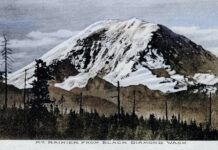The Enumclaw Cooperative Creamery has a long and detailed history which includes this photo of three young men standing in the building’s door. Only Harry Christiansen in the center has been identified. The Co-op’s beginnings date to 1897 when Otto Sheals started a small creamery where butter was made.
Two years later, George Bruhn of Danish descent helped farmers organize an association to increase profits for their local dairies. The new organization was intended to boost local dairy farmers through cooperative processing and marketing. Founders included Otto Tamm, Rick Lanier, Otto Bruhn, B.B. Seville, Matt Malneritch, David P. Jones, and Charles Schomberg.
The cream and butterfat were the prized portion of the raw product milked from cows. The residual skim milk was often fed to pigs or dumped out, though farmwives became very enterprising in finding ways to use low-fat milk. However, as a commodity the price of butterfat varied widely leading to financial ups and downs for the Co-op. At the time refrigeration was both rare and expensive so milk soured quickly in warm weather. A 1905 typhoid epidemic in Enumclaw was in fact traced to one local dairy farm, making better hygiene practices imperative.
Hard times in 1908 brought the Cooperative to the brink of failure. Dave Van Patten stepped in to manage the operation and steered it to survival. Under his guiding hand the plant expanded and prospered. By 1911, the creamery installed refrigeration and started bottling Grade-A milk, which Louie DuChateau delivered around town. A 1914 article reported that Enumclaw dairymen managed 3,000 cows, the majority being Jersey, though quite a few raised Holsteins and Guernsey. Further processing improvements in 1927 increased business to nearly $1 million per year. The creamery weathered the first years of the depression but had to reorganize in 1930. That year the Co-op handled two millions pounds of butterfat with 17 milk trucks.
After World War II, the plant became outdated, having gradually been superseded by larger plants in the Kent valley. The Enumclaw Co-Op Creamery passed into history in 1951 under its last president, Ira Baker. Following its closure, Darigold and Carnation tankers hauled tanker loads of Enumclaw’s raw milk to Seattle where it was bottled and shipped back to the town from whence it came. This photo comes courtesy of JoAnne Matsurmura ,whose research was originally financed by Dwight Garret,t who had an interest in the property where the old creamery building stood and was eventually demolished.







